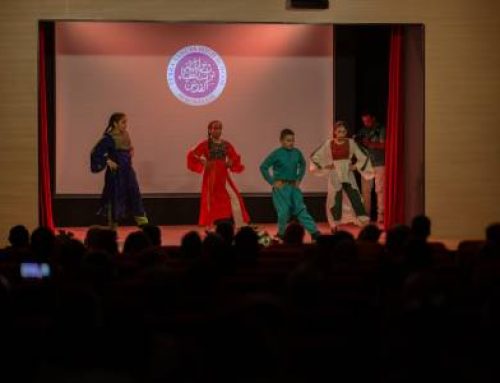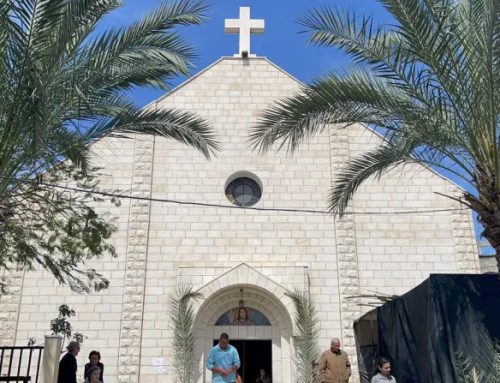This is why at this year's Conference, HCEF presents the Labyrinth Prayer for Peace, which will be on display and open to all attendants of HCEF's 10th International Conference on October 25, 2008 at the National Presbyterian Church in Washington, DC.
The Labyrinth Prayer for Peace will provide an opportunity for you to reflect in thoughtful meditation and prayer on our past achievements and future challenges.
Congregation members walk the Labyrinth at Crusader Lutheran Church in Rockville, MD
A traditional labyrinth is inlaid onto a floor or the ground and has a single path for walking into and returning from its center. The labyrinth at HCEF's Conference will be a portable, 35-square-foot floor canvass that Conference goers can access throughout the day's events — either during breaks between sessions, or at times when you want a moment of reflection for yourself.
This unique feature at this year's Conference was made possible in partnership with the Crusader Lutheran Church of Rockville, MD. Commenting on the endeavor, HCEF President/CEO Rateb Rabie said, "The Labyrinth is an expression of prayer, meditation and ecumenism, available to people of all faiths, which is why it is perfect for our Conference. It represents our own prayer that the walls that separate people will soon be dissolved."
The Labyrinth will be administered by Steve Corbin, Vice President of Crusader Lutheran's Church Council. In preparation for the Labyrinth, Mr. Corbin gave his own reflections: "As we walk the Labyrinth and reflect on our blessings, faith and responsibilities, we should envision our brothers and sisters in the Holy Land.
"They are challenged by political and economic hardships that are hard to imagine, yet they remain faithful. And they have repeatedly told us how important our support is to them — not just material support, but prayer, friendship, and advocacy. Let your steps and reflections on the Labyrinth be the start of a personal walk toward the Holy Land that can lead you to actually become a pilgrim in the land where our Lord and his disciples walked. There can be no better time to make such a commitment than now."
What is a labyrinth?
A labyrinth is not a maze, a puzzle or a game. It has no wrong turns or dead ends. The labyrinth is a sacred path that will always take you to the center and back out again.
Labyrinths date back thousands of years and have appeared in numerous cultures around the world. The first evidence of a labyrinth is the drawing of one on the walls in the ancient city of Pompeii. The earliest known Christian labyrinth is in a church in Algeria dating back to the 4th century. The most famous labyrinth is the one at Chartres Cathedral in Chartres, France that was created in the 13th century. The labyrinth at HCEF's Conference is based on the Chartres design.
In the Middle Ages, labyrinths were often used to represent a pilgrimage to Jerusalem by those who could not make the trip.
Walking the labyrinth is an experience unique to each person who walks. It is meant to be a time of spiritual centering and reflection. Walking the labyrinth is a meditation, time out from the hectic, noisy lives we live. (No cell phones allowed in the labyrinth.)
There is no wrong way to walk the labyrinth. It is a metaphor for our own spiritual paths: all paths lead to God (the center) and we carry this deeper sense of connection back out into the world. You can walk the path with the intention of focusing on an issue in your life. It may be helpful to walk while praying a certain prayer or reciting a particular verse of Scripture. Some people focus on just one word (or mantra) such as, "Peace", "Grace", or, "Joy."
What are people saying about the Labyrinth?*
"It (the labyrinth) slows you down and takes you out of your present world. It allows you to think about the things important to your life — God, family and friends." — Liz Roybal
"It's a real meditative experience. It eliminates the outside as you take the walk forward and think about your own life and what God has done to help you." — Ben Borchelt
"I didn't know what to expect. But, I as I walked and prayed and experienced, I could feel peace and that I was being heard. I felt chills go up and down my spine." — Mildred Hamernik
"I need to do it again!" — Patricia Hintze
"I had a huge experience. When I was walking, I felt lighter the farther I went into it. Walking farther I felt like I was going farther in my life. It made me pay attention so that I didn't accidentally go backwards like in life. God was with me." — Luke Murphy (age 10)
"The labyrinth was a place for me to relax and think about things that I never have time to think about. It's a place with no worries." — Derek Corbin (age 13)
"My first impression was one of beauty and awe — even just the labyrinth canvas itself. Walking brought peace, tranquility and quiet. It's not a maze and there are no dead ends. You take a lot of the reflective experience with you when you leave." Carol Borchelt
* Quotes provided by Rev. Sandra Cox Shaw and Steve Corbin of Crusader Lutheran Church.
Rev. Sandra Cox Shaw and her children enjoy the Labyrinth at Crusader Lutheran Church







